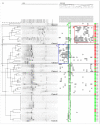Comparison of the vaginal microbiota diversity of women with and without human papillomavirus infection: a cross-sectional study
- PMID: 23758857
- PMCID: PMC3684509
- DOI: 10.1186/1471-2334-13-271
Comparison of the vaginal microbiota diversity of women with and without human papillomavirus infection: a cross-sectional study
Abstract
Background: The female genital tract is an important bacterial habitat of the human body, and vaginal microbiota plays a crucial role in vaginal health. The alteration of vaginal microbiota affects millions of women annually, and is associated with numerous adverse health outcomes, including human papillomavirus (HPV) infection. However, previous studies have primarily focused on the association between bacterial vaginosis and HPV infection. Little is known about the composition of vaginal microbial communities involved in HPV acquisition. The present study was performed to investigate whether HPV infection was associated with the diversity and composition of vaginal microbiota.
Methods: A total of 70 healthy women (32 HPV-negative and 38 HPV-positive) with normal cervical cytology were enrolled in this study. Culture-independent polymerase chain reaction-denaturing gradient gel electrophoresis was used to measure the diversity and composition of vaginal microbiota of all subjects.
Results: We found significantly greater biological diversity in the vaginal microbiota of HPV-positive women (p < 0.001). Lactobacillus, including L. gallinarum, L. iners and L. gasseri, was the predominant genus and was detected in all women. No significant difference between HPV-positive and HPV-negative women was found for the frequency of detection of L. gallinarum (p = 0.775) or L. iners (p = 0.717), but L. gasseri was found at a significantly higher frequency in HPV-positive women (p = 0.005). Gardnerella vaginalis was also found at a significantly higher frequency in HPV-positive women (p = 0.031). Dendrograms revealed that vaginal microbiota from the two groups had different profiles.
Conclusions: Our study is the first systematic evaluation of an association between vaginal microbiota and HPV infection, and we have demonstrated that compared with HPV-negative women, the bacterial diversity of HPV-positive women is more complex and the composition of vaginal microbiota is different.
Figures



References
Publication types
MeSH terms
LinkOut - more resources
Full Text Sources
Other Literature Sources
Molecular Biology Databases

